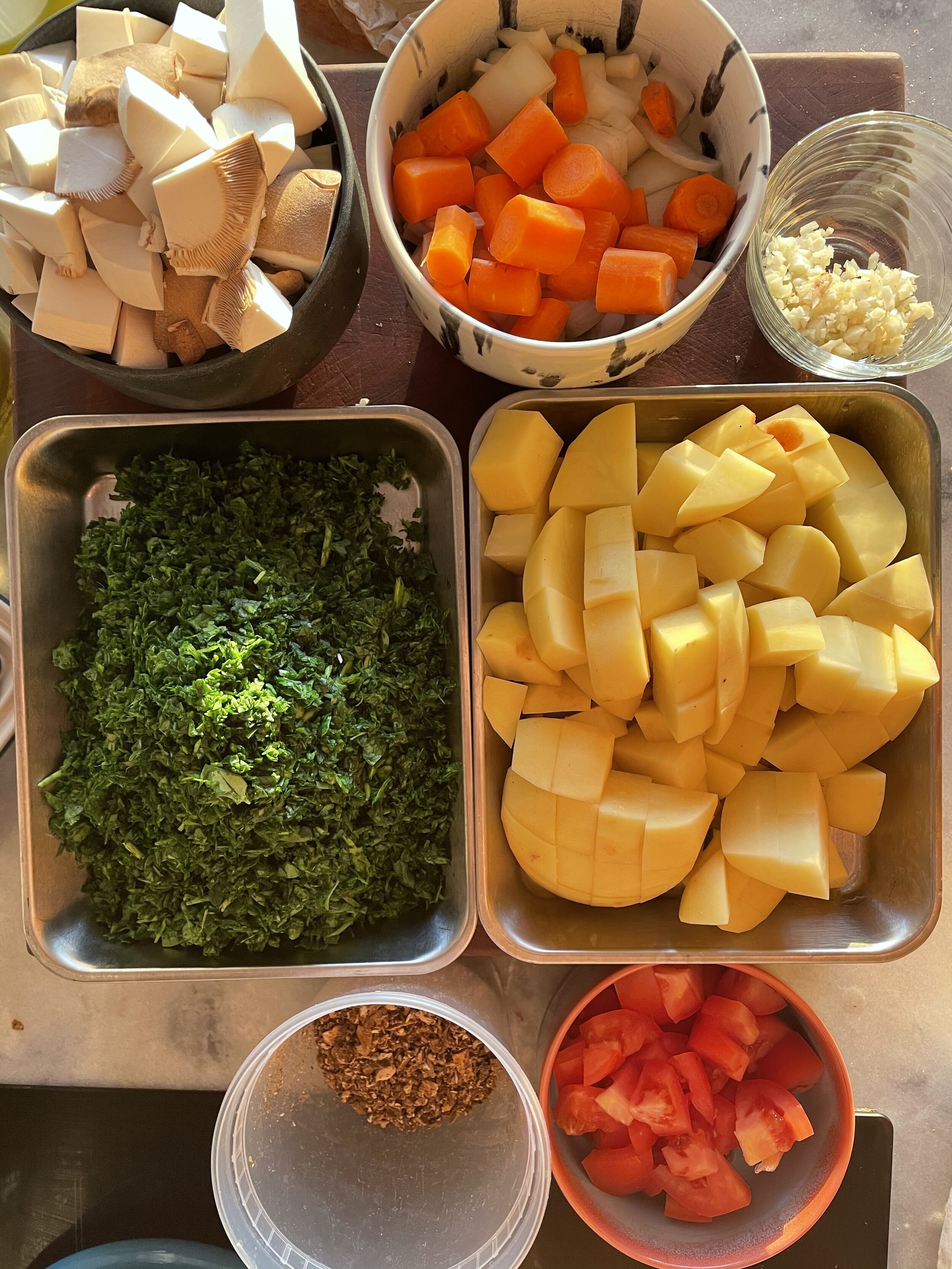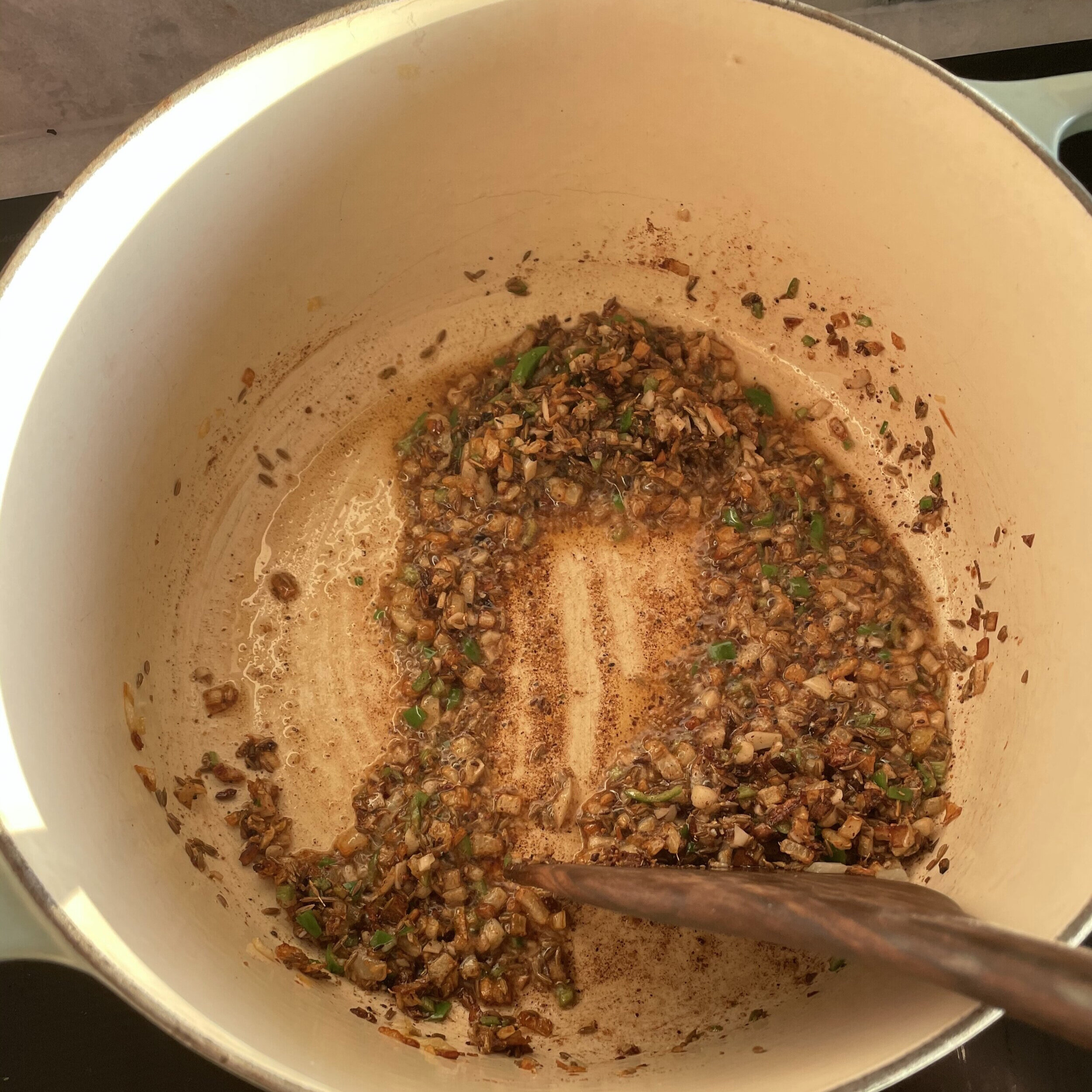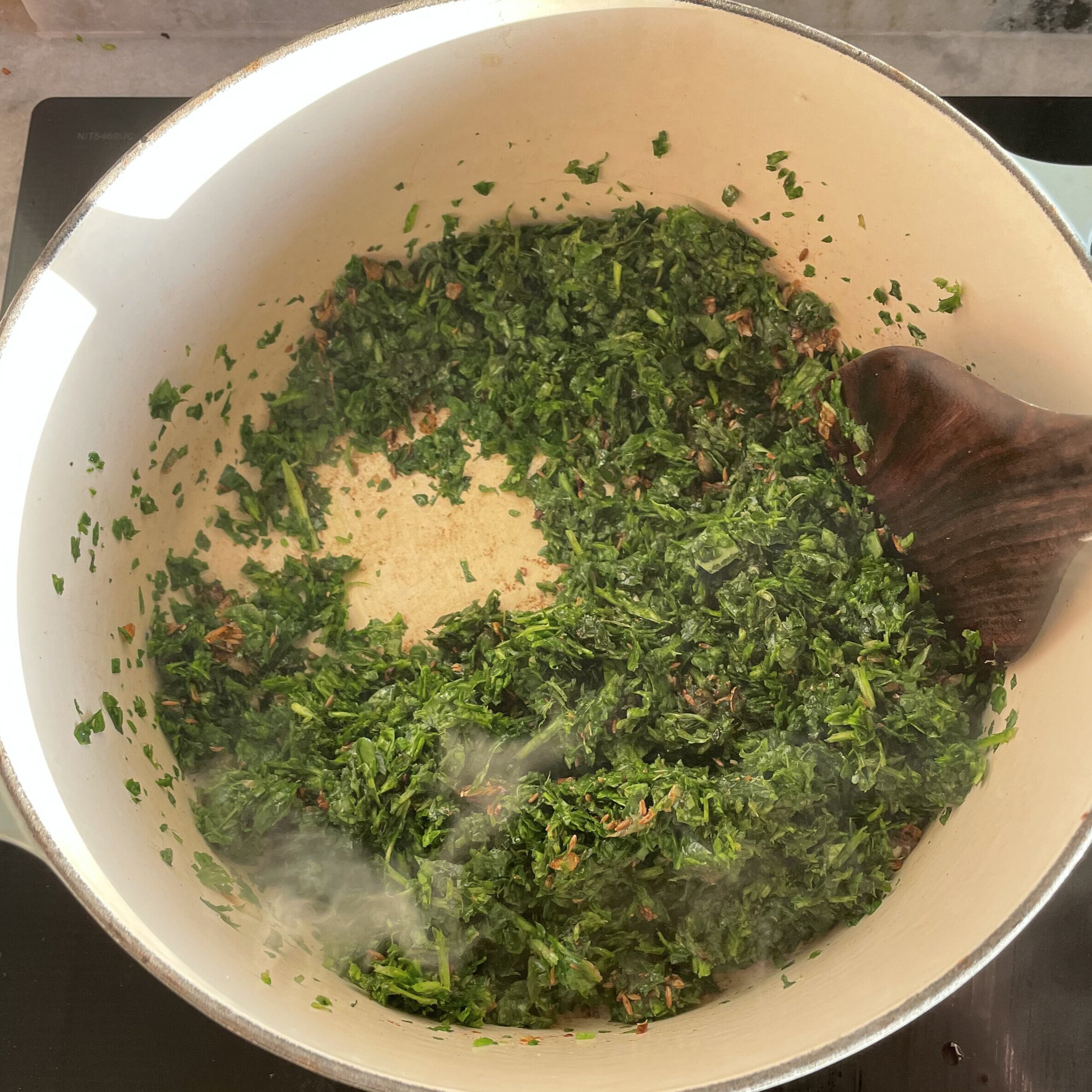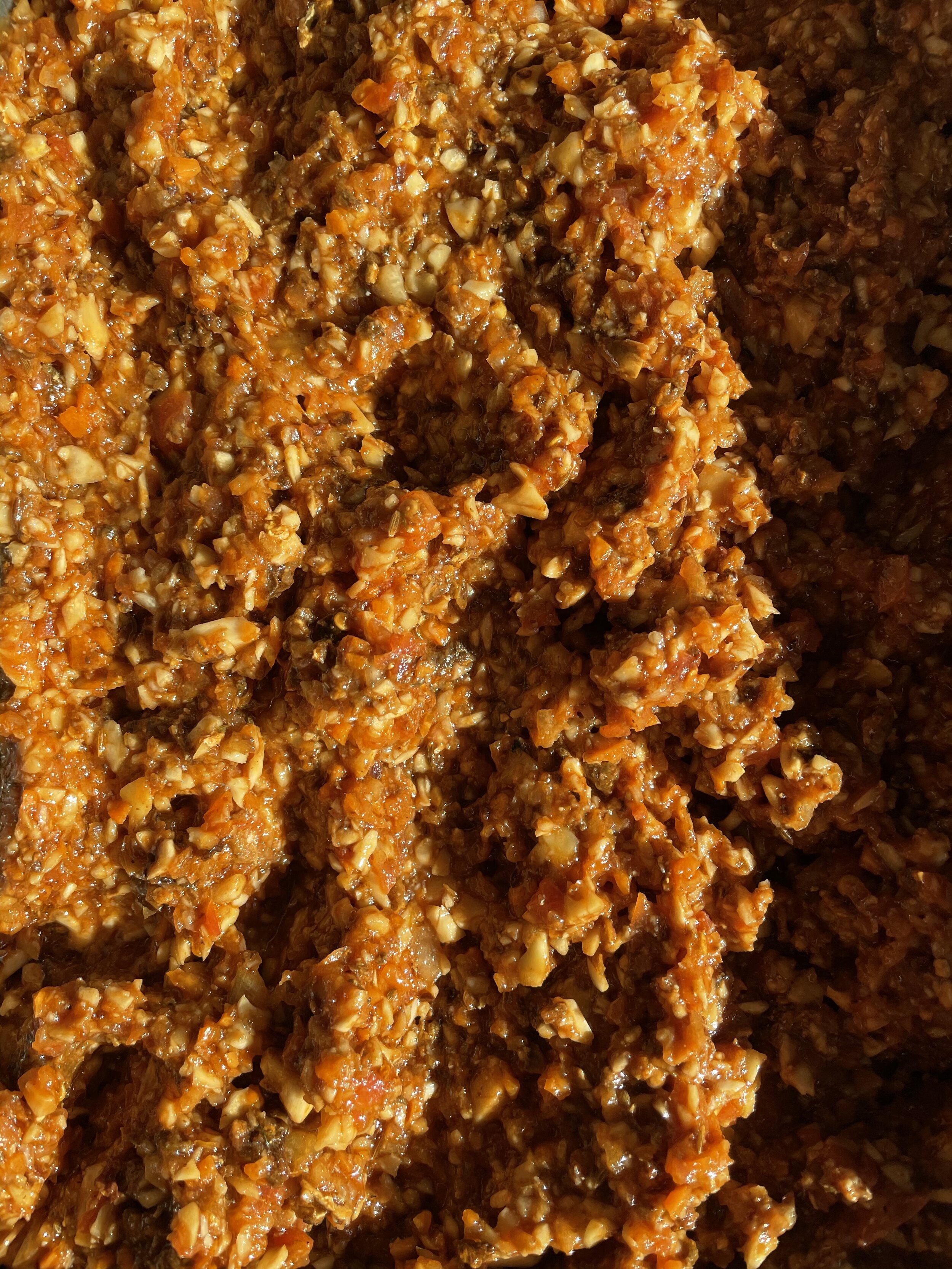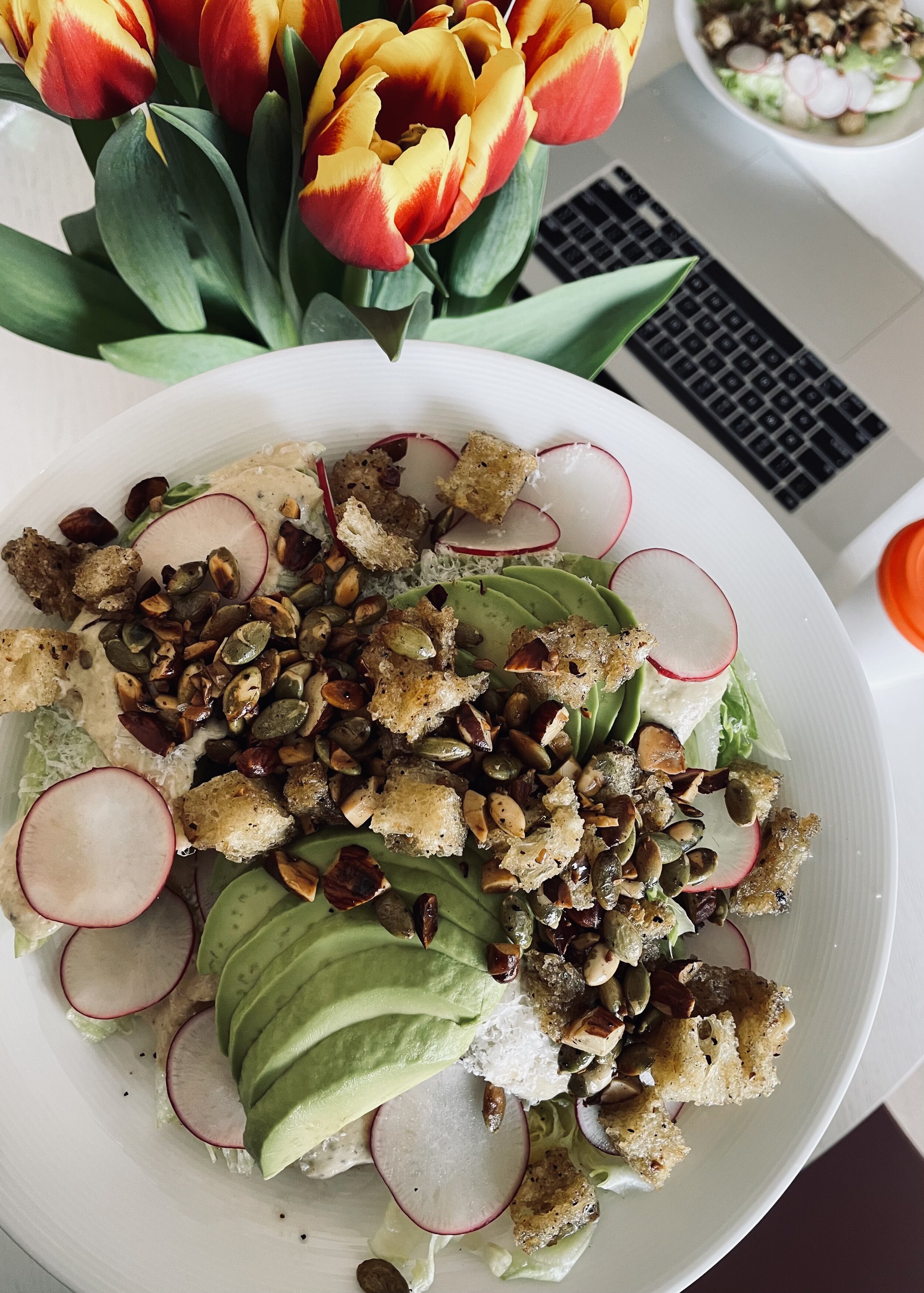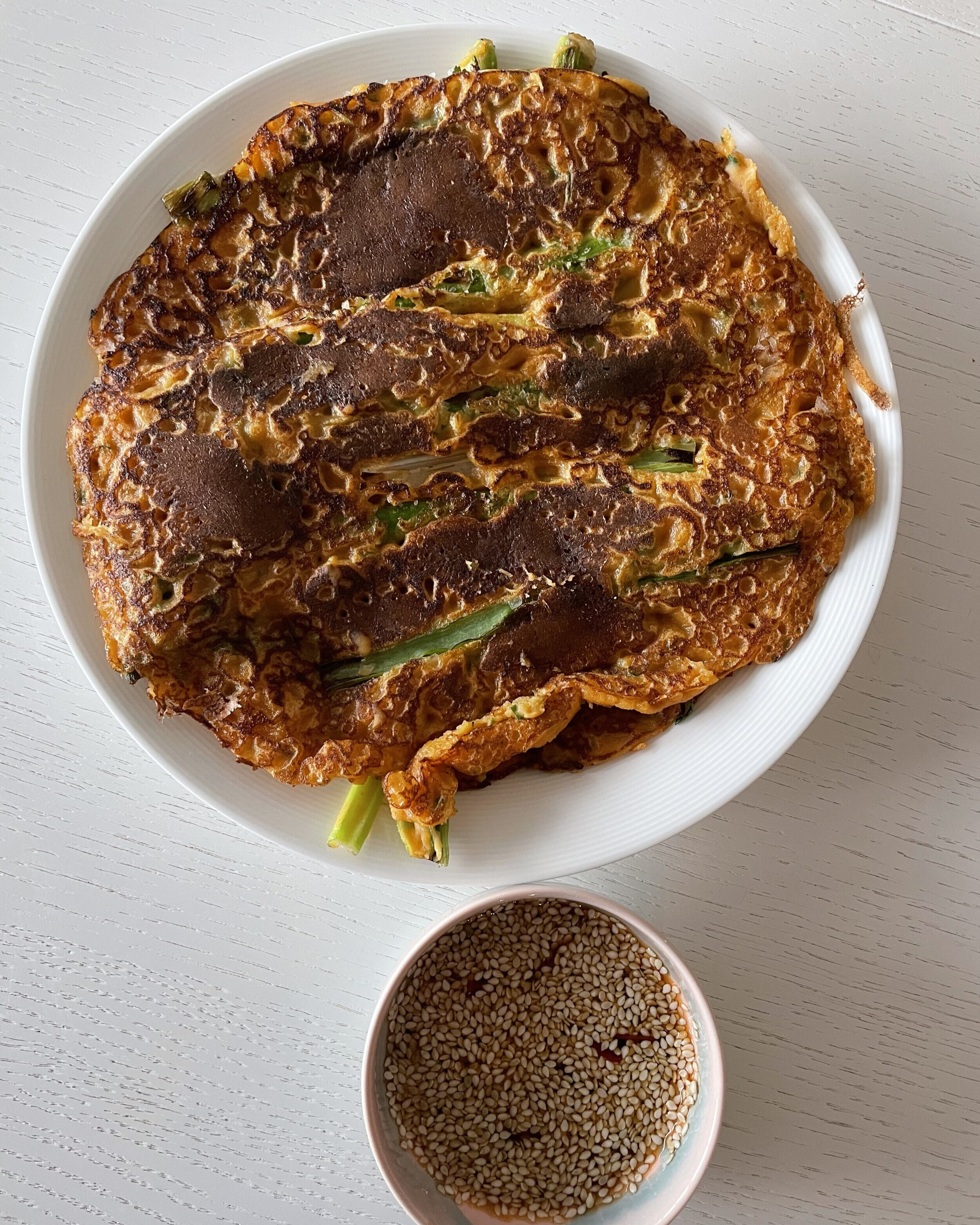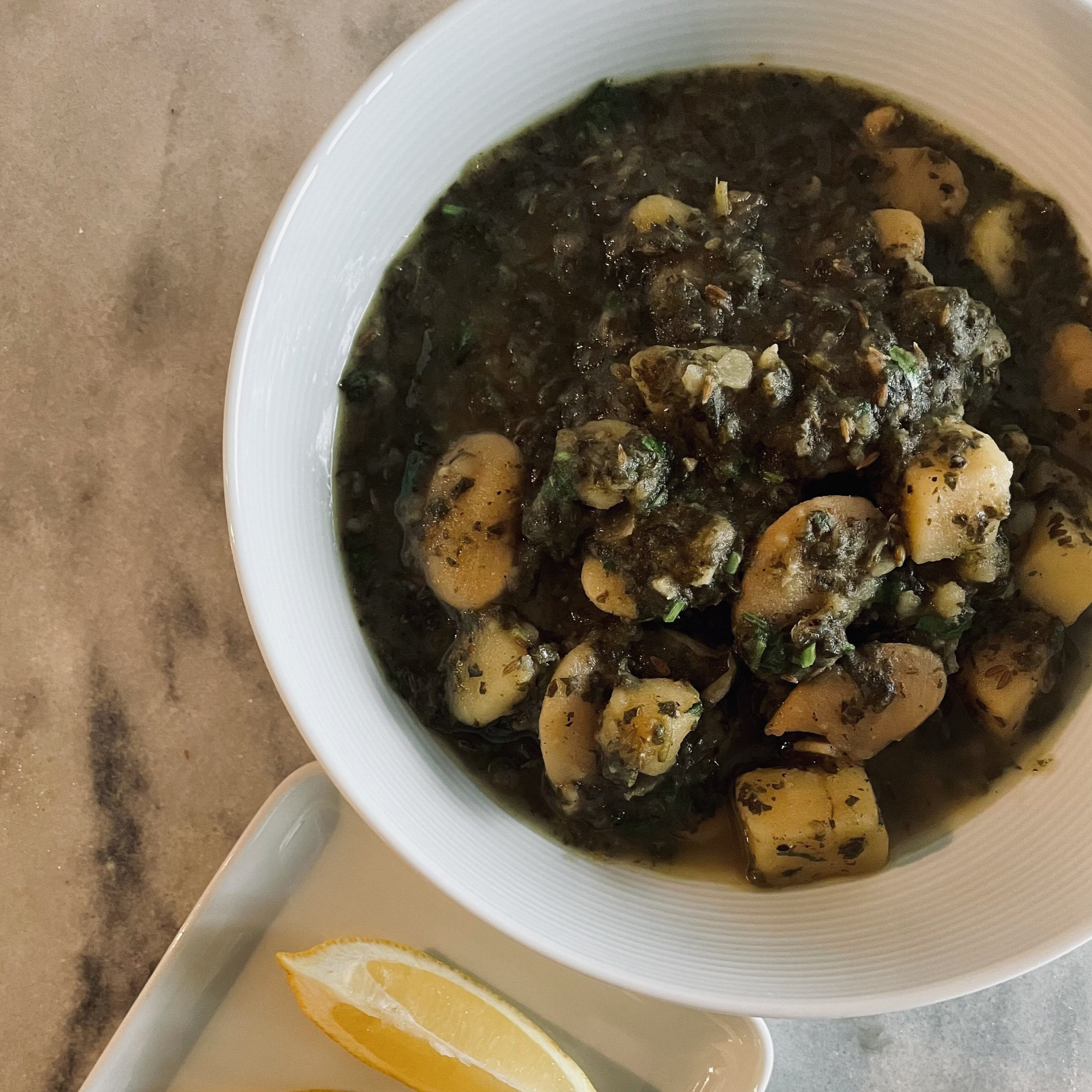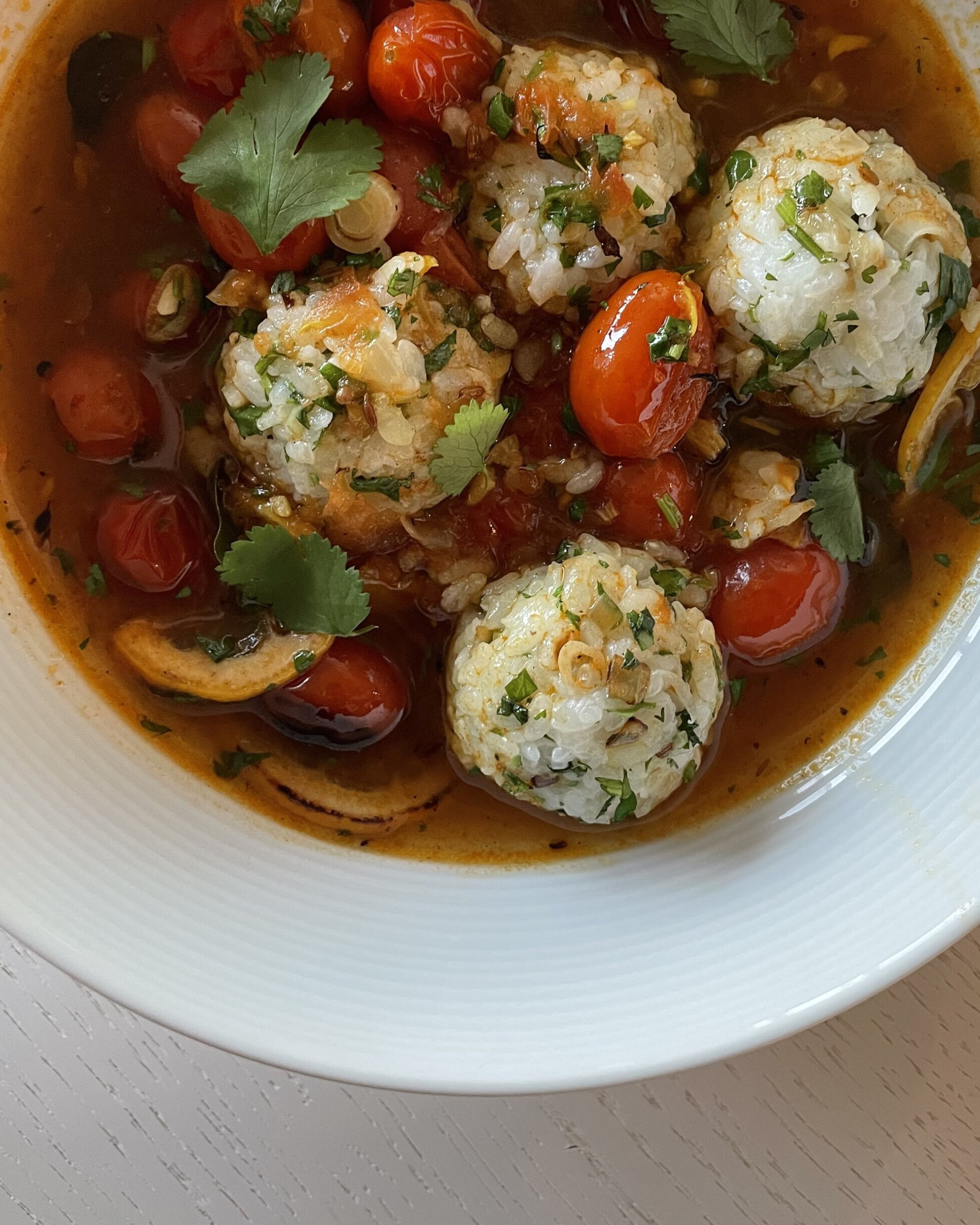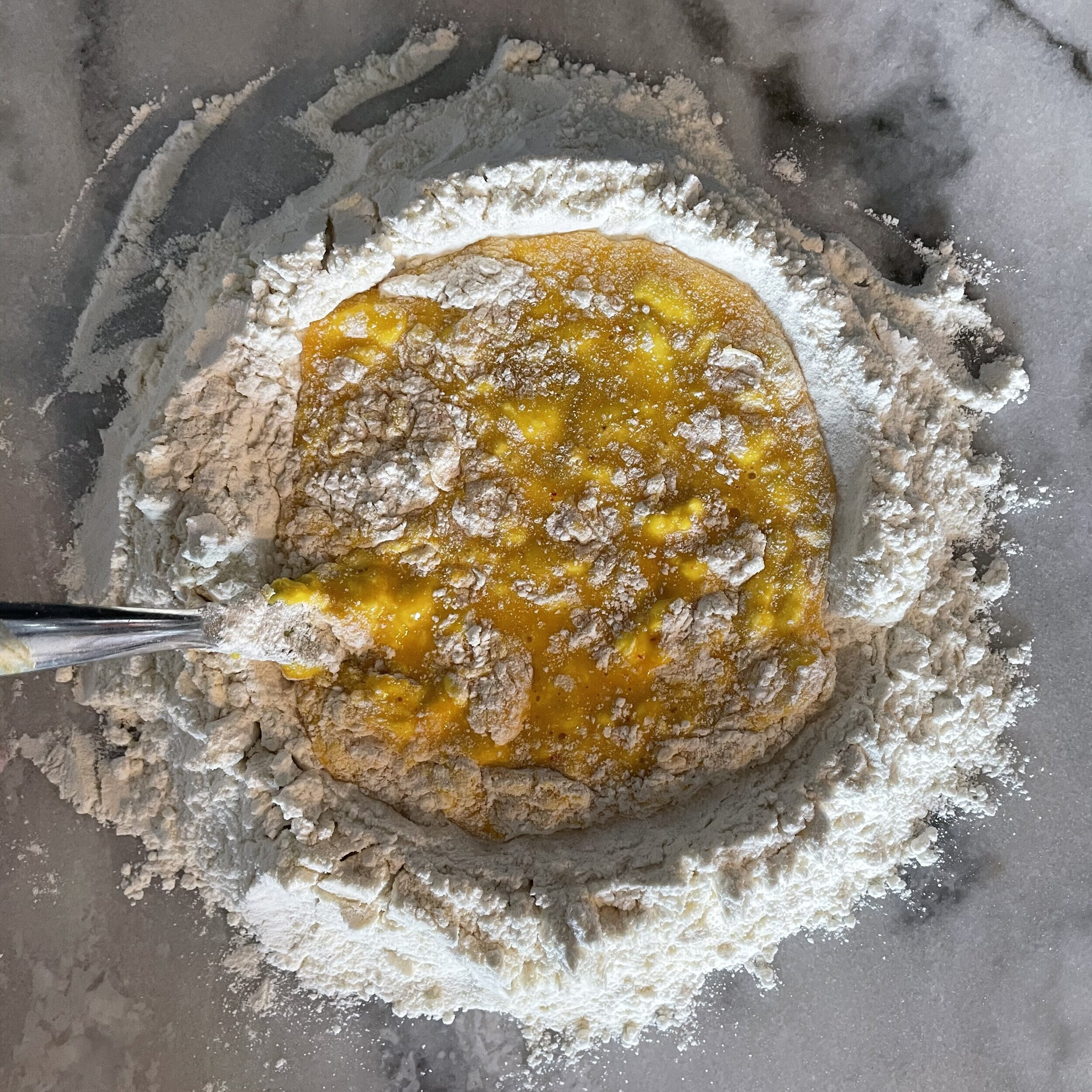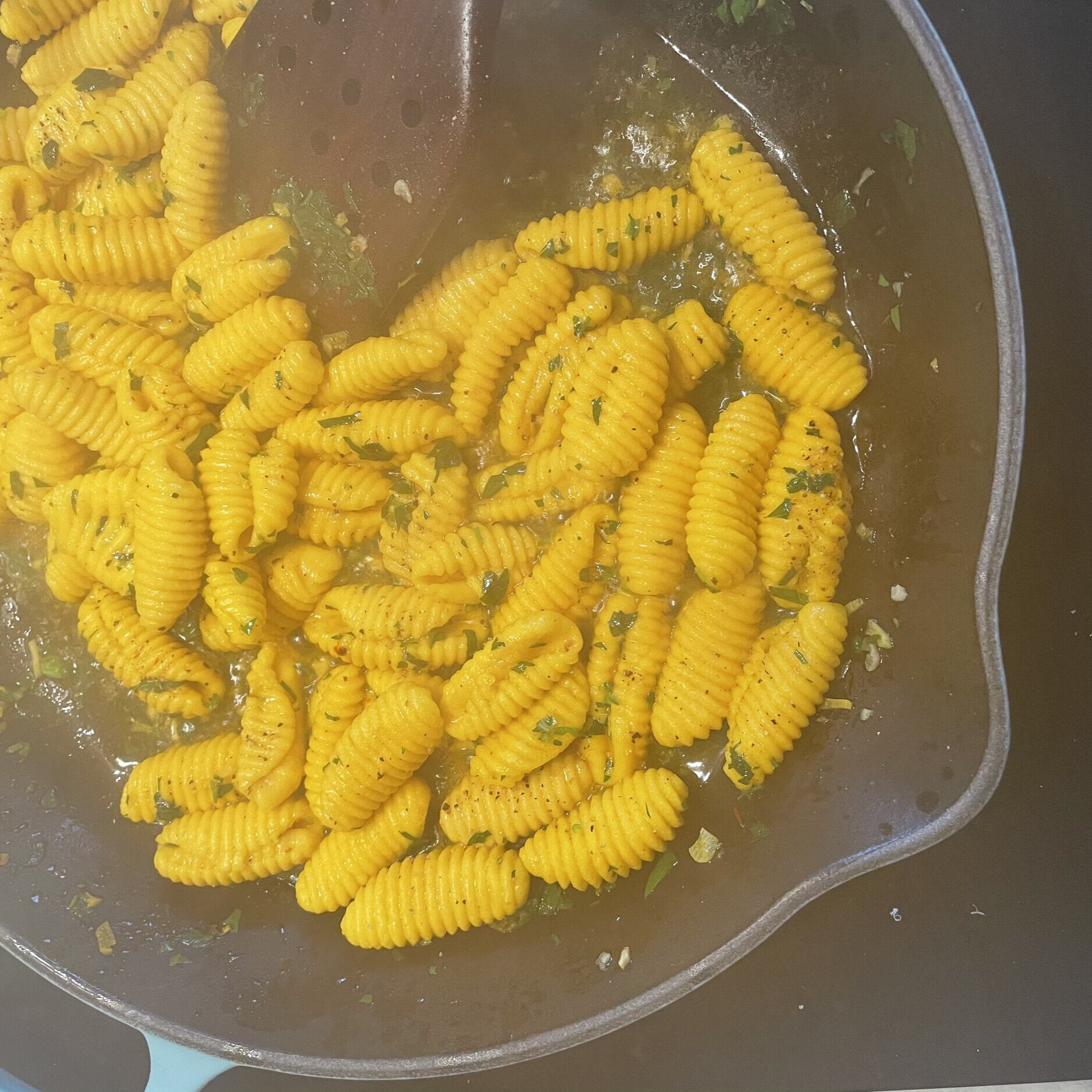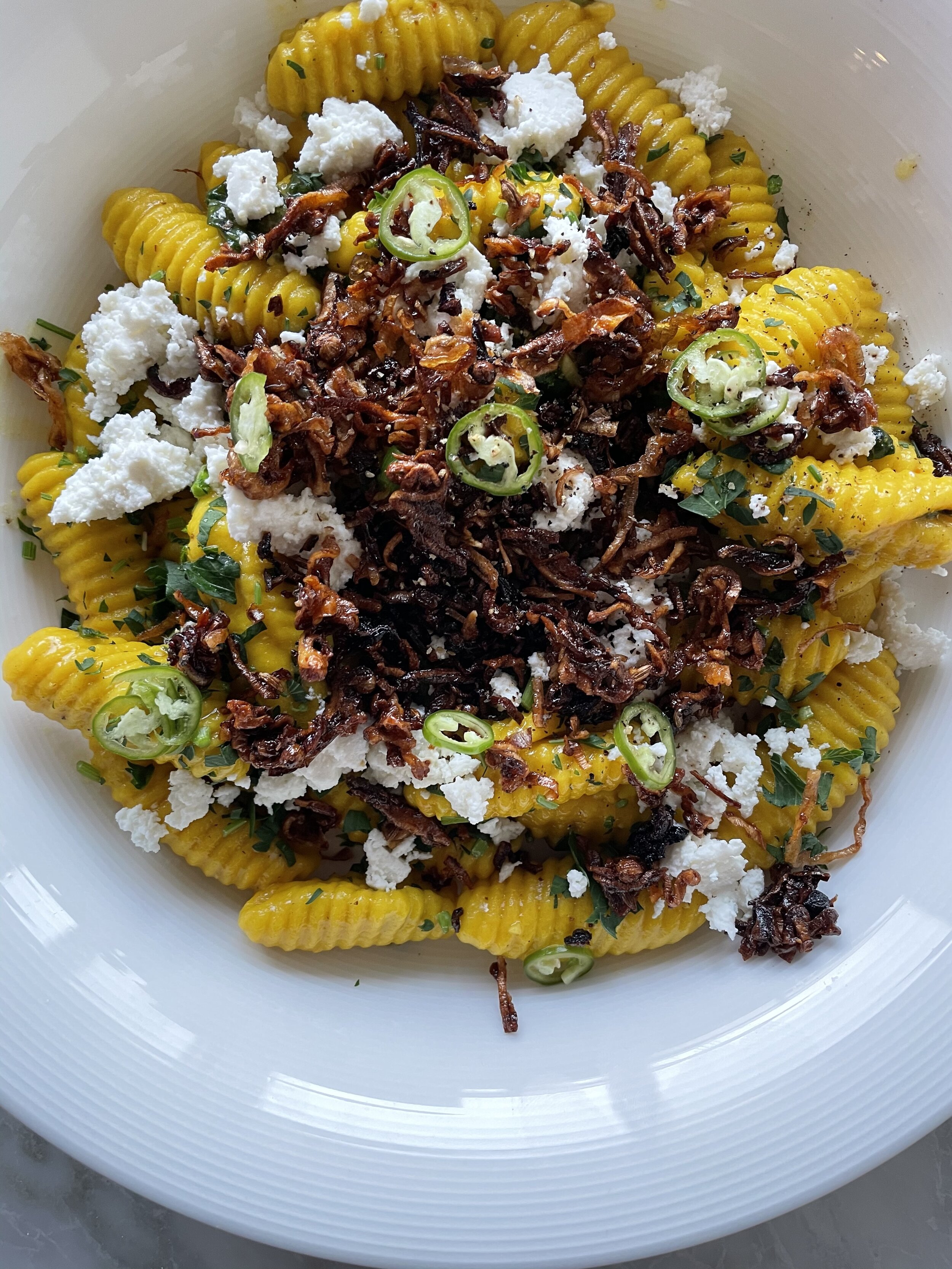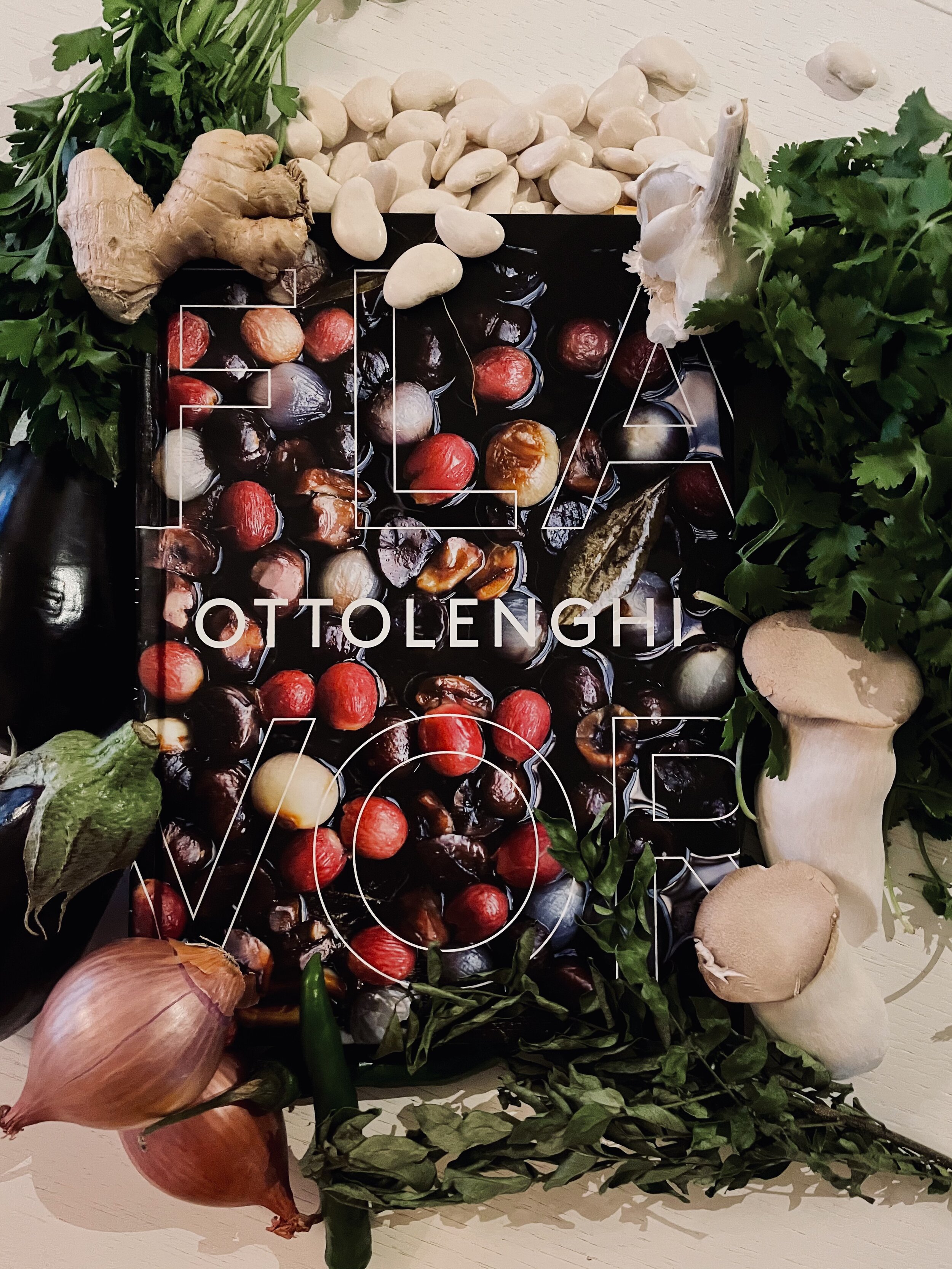
Enter the Ottolenghi Verse
Flavour by Yotam Ottolenghi
I think by the time I work my way through my cookbook shelf I’ll have meal planned from half a dozen Ottolenghi cookbooks. I remember when I first got Plenty and the self titled Ottolenghi. I think this was a discovery point for a lot of home cooks: How do you deseed a pomegranate? What is a nigella seed? How many eggplants can one person eat? Ottolenghi has been pretty consistent about the last one: lots. The criticism of those early books was who needs to buy dozens of “obscure” ingredients and spices to make one dish. But, unsurprisingly, the question wasn’t “why did I buy all this sumac”, but actually “what else can I do with this?” Every cookbook since then has delivered on that questions with simpler but equally interesting recipes for home cooks to use up the cumin seeds in their pantries. This book is more directly in that vein, with tips on how to stock a flavourful pantry, and what ingredients to lean on.
One of the major contributions of Plenty was that it birthed thousands of impressive, satisfying, vegetarian dinner parties (in my house alone). I don’t think home cooks had been tasked until then with thinking creatively about how to turn squash or rice dishes, normally sides to a slab of meat, into the main event. This book is in that same tradition, but confronts techniques of building umami more directly. It’s a user guide cooking techniques that build flavour in plant based recipes. Like the donabe cookbook, doing my meal plan here will get you a great week of food, but you want to pick up the book to get all the details and wealth of advice.
The last thing I’ll say about Ottolenghi is that he is a great teacher. Some books I do on this site kick my ass with recipes designed for chefs and professional kitchens. Ottolenghi really understands home cooking and cooking for friends and maybe it’s clichéed or basic to fangirl over him in this way but he’s very good at what he does.
The recipes
I am cutting all the recipes to serve 2 people except where I feel like leftovers will be great: the ragu and the bkeila stew.
Prep
Beets
Lime butter
Bkeila Stew
Ragu
Pancake dipping sauce
Sticky rice balls
Lunch
Iceberg Wedges with Smoky Eggplant Cream (p.38)
Hasselback Beets with Lime Leaf Butter (p.50)
Asparagus and Gochujang Pancakes (p.102)
Dinner
Bkeila, potato, and butter bean stew (p. 75)
Saffron Taglietelle with Ricotta and Crispy Chipotle Shallots (p.199)
Sticky Rice Balls in Tamarind Rasam Broth (p.180)
Ultimate Roasting-Pan Ragu with Polenta (p.101)
Dessert
Tapioca fritters with orange syrup and star anise (p.280)
Shopping list
I always assume you have salt, pepper, olive oil, and flour.
Vegetables & fruits
Asparagus
Eggplant (1 medium)
Lemon (3)
Small iceberg lettuce
Rainbow or breakfast radishes
Avocado (1)
Medium large beets (4-5)*
Lime
Green chile (6)
Waxy potatoes (250g)
Baby spinach
Carrots (2)
Oyster mushrooms (240g)
Porcini mushrooms (50g)
Plum tomatoes (2-3)
Red chile (1)
Cherry tomatoes
Plum tomatoes (3-4)
Chives
Makrut (kaffir) lime leaves
Cilantro (3 bunches)
Parsley
Fresh curry leaves
Fresh turmeric
Fresh ginger
* Or use pre-cooked beets! That’s what I did.
Spices & Seeds
Urfa chile flakes
Ground cumin
Ground coriander
Ground cinnamon
Sesame seeds
Pumpkin seeds
Cumin seeds
Black mustard seeds
Dried red chiles
Saffron
Coriander seeds
Chipotle flakes
Alliums
Garlic (2 bulbs)
Green onions
Shallots (2)
Onion (2)
Pantry
Dijon mustard
Almonds
Sourdough bread
Superfine sugar
1 jar good-quality butter beans
Rose harissa
Tomato paste
Dried brown lentils
Coconut cream
Polenta
Soy sauce
Honey
Rice flour
Gochujang chile paste
Block of tamarind pulp
Thai sticky rice
”00” Flour
Semolina flour
Maple syrup
Oils, vinegars, etc.
Soy sauce
Rice vinegar
Sunflower oil
Red wine
Dairy & Freezer
Greek yoghurt
Parmesan
Butter
Heavy cream
Vegetable or chicken stock
White miso paste
Eggs (2)
Ricotta
Vegetable or chicken stock (2L)
Prep
Mise en place
45 minutes
For the Bkeila, potato, and butter bean stew: In batches, put the 2 cups of cilantro, 15g parsley, and 300g baby spinach into a food processor and pulse until finely chopped. Set aside. Peel and cut 250g waxy potatoes into 1 1/4-inch pieces. Seed and mince 1 green chile. Finely chop 1/2 onion. Crush 3 garlic cloves.
For the ragu: Peel and chop 2 carrots into large chunks. peel and chop 1 onion into large chunks. Roughly chop 240g oyster mushrooms. Roughly blitz 50g porcini mushrooms in the food processor. Crush 3 garlic cloves. Chop 1-3 plum tomatoes into large chunks.
For the sticky rice balls: Put 100g Thai sticky rice in cold water to soak for an hour. Finely chop half an onion.
Start cooking
3 hours (some of it just hanging out)
Preheat the oven to 400˚F/190˚C fan.
Make the stew
Put 2 1/2 tbsp olive oil into a large, heavy-bottomed pot on medium heat. Add the onion and fry gently for 8 minutes, stirring occasionally, until soft and golden. Add the garlic cloves, green chile, 2 tsp ground cumin, 1/2 tbsp ground coriander, and 1/2 tsp ground cinnamon.
Increase the heat to high and add the chopped herbs and spinach to the pot along with the remaining 1 1/2 tbsp olive oil. Cook for 10 minutes, stirring occasionally, until the spinach turns dark green. You want the spinach to catch a little but not burn, so decrease the heat if necessary. Stir in 3/4 tsp superfine sugar, 2 tbsp lemon juice, 500ml vegetable or chicken stock, and 1 tsp salt. Decrease the heat to medium, add the potatoes, and cook gently until they are soft all the way through, about 25 minutes. Add 350g jarred butter beans and cook until warmed through, about 5 minutes.
Remove the pot from the heat. Cool and store.
Make the ragu
Working in batches, put the carrots, onion, oyster mushrooms, porcini mushrooms, garlic, and tomatoes into a food processor and pulse until everything is finely chopped. Put the vegetables into a 9x13inch nonstick roasting pan with at least 2 1/2-inch sides and add 90ml olive oil, 3 tbsp miso paste, 2 tbsp rose harissa, 3 tbsp tomato paste, 75ml soy sauce, and 1 1/2 tsp cumin seeds, and mix very well. Bake for 40 minutes, stirring halfway through, until browned in places and around the edges.
Make the lime leaf butter
Put 90g butter, 7 1/2 tsp olive oil, 5 fresh markrut lime leaves, 10g peeled and finely chopped ginger, and 1 clove chopped garlic in a small saucepan and place on medium-high heat. Cook gently until the butter melts and begins to bubble, about 4 minutes, then remove from the heat and set aside to infuse for 40 minutes. Strain and discard the aromatics. Stir in 1 tbsp lime juice and 1 tsp flaked salt. Store in the fridge.
Finish the ragu
Decrease the oven temperature to 375˚F/180˚C fan.
Add the 145g lentils, 80g pearl barley, 770ml vegetable stock, 130g coconut cream, 80ml red wine, 120ml water, 1/4 tsp salt and a very generous grind of pepper to the roasting pan. Stir very well, scraping the crispy sides and bottom with a spatula. Cover tightly with aluminum foil and bake for another 40 minutes. Remove the foil and bake for a final 5 minutes. Cool and store in the fridge.
Mix up a dipping sauce
In a small jar, add 3 tbsp soy sauce, 1 tbsp honey, 2 tsp sesame seeds, 2 tsp rice vinegar, 1 clove of garlic, crushed, and 1/2 red chile, seeded and finely chopped. Put the lid on the jar and shake to combine. Store in the fridge.
Make the sticky rice balls
Put the drained rice into a medium saucepan for which you have a lid. Add 110ml water and a pinch of salt. Bring to a boil on medium-high heat then decrease the heat to medium-low and cover loosely with the lid, leaving a small gap for steam to escape. Cook for 20 minutes there remove from the heat and let sit, uncovered, until cool.
Put 1 tbsp sunflower oil into a sauté pan on medium-high. Add the onion and cook for 7 minutes, until softened and browned. Add one clove of crushed garlic and 7g peeled, finely grated ginger and cook for 90 seconds. Remove from the heat and transfer to a bowl. Add the cooked rice, 5g chopped cilantro, and 2 thinly sliced green onions and mix well. With light oiled hands, form into 6 balls, weighing 30g each. Line a container with a lid with parchment and put the balls inside, if possible, not touching. Seal and store in the fridge.
Bake the beets (if you are starting from raw)
Preheat the oven to 450˚F/220˚C fan.
Place the raw beets in a baking dish big enough for them to fit in a single later. Fill the dish with enough water to come 3/4 inch up the sides. Sprinkle with salt, cover tightly with aluminium foil, and bake for 1 hour and 20 minutes, or until a knife inserted goes through easily. Discard the water and, when the beets are cool enough to handle, peel off the skin under cold running water. Halve any large beets lengthwise. Store covered with plastic wrap in the fridge.
Lunches
Iceberg Wedges with Smoky Eggplant Cream
For the cream: Place a well-greased griddle pan on a high heat and ventilate your kitchen. Poke the eggplant with a fork seven or eight times all over and, once the pan is smoking, grill it for about 45 minutes, turning occasionally, until the outsides are completely charred and the insides soft.
Transfer to a colander set over a bowl and, once cool enough to handle, remove the flesh; discard the stems and as much of the charred skin as you can. Measure out 100g aubergine flesh, and reserve any excess for another use.
Transfer to a food processor with the remaining 3tsp lemon juice, half a garlic clove, 1 1/2 tbsp greek yoghurt, 1 tsp dijon mustard, 30ml olive oil, a pinch of salt and a good grind of black pepper, and blitz until smooth.
Meanwhile, make the topping. Put 1/2 tbsp olive oil in a large frying pan on a medium-high heat. Once hot, add 30g roughly chopped almonds and cook, stirring often, for about two minutes. Add 50g sourdough, crusts removed and blitzed into coarse crumbs, 25g pumpkin seeds, and a pinch of salt, and cook, stirring continuously, for five minutes more, until golden. Add a pinch of urfa chile flakes, cook for another 30 seconds, then transfer to a tray and leave to cool completely.
To assemble, divide the about 175g iceberg lettuce wedges between two plates. Top each portion with 3/4 tsp of olive oil and a sprinkling of salt and pepper. Spoon over the aubergine cream, followed by grated parmesan, a few thinly sliced radishes and half an avocado each, thinly sliced. Sprinkle again lightly with salt and pepper, then drizzle the last tablespoons of olive oil on top. Scatter over some sliced chives and a generous helping of the crunchy topping, and serve any extra topping alongside.
This is not a simple salad, it requires a skillet, a grill pan, a mandoline (or great knife skills), and a food processor. But, the end result is impressive. It might work best as a weekend lunch, or even a brunch with some scrambled eggs on the side — if you can stand cleaning one more pan.
Hasselback Beets with Lime Leaf Butter and Sourdough toast
Preheat the oven to 400˚F/190˚C.
Take the cooked beets and lime butter out of the fridge. Melt half the lime butter in a small saucepan.
Line a small baking sheet with parchment. Place one beet at a time in the cup of a wooden spoon and cut slits in the beets at 1/8-inch intervals, stopping about 3/8-inch from the bottom so that the slices stay connected. Place the beets on the baking sheet and fan the slices out as much as possible. Spoon the melted butter mixture evenly over and around the beets and especially between the slices. Roast for 1 1/4 hours, basting every 20 minutes with the butter in the baking sheet, until the edges are crisp and caramelized. Set aside to cool for 15 minutes.
Meanwhile, make the sauce: In a small bowl, stir together 5 minced or blended lime leaves, 1/4 tsp peeled and finely minced ginger, 1/2 clove of crushed garlic, 1/3 green chile, minced, 1/2 tbsp minced cilantro, 1 1/2 tbsp olive oil, and a pinch of flaky salt and set aside.
For the cream: In a medium bowl, whip 40ml heavy cream, 45g greek yoghurt, and a light pinch salt until light and fluffy with medium peaks, about 3 minutes. Set aside in the fridge.
Toast some crusty sourdough with butter.
When you’re ready to serve, spread the yoghurt on a platter, then arrange the beets on top, spooning any butter mixture from the pan over and around them. Drizzle with the sauce, finish with 1 tsp lime juice, and serve at once.
Asparagus and Gochujang Pancakes
Put 135g all-purpose flour and 60g rice flour into a large bowl, add 1/2 tsp salt, and mix well to combine. In a separate bowl, lightly whisk together 1 egg, 325ml water, 4 1/2 tsp gochujang, 5g roughly chopped cilantro, and 1/2 red chile, seeded and minced. Make a well in the center of the flour mixture, slowly pour in the wet ingredients and whisk until just smooth; don’t overmix.
Add just over 1 tbsp sunflower oil to a 7-inch nonstick pan on medium-high heat. Once hot, add 100g trimmed asparagus, all pointing in the same direction, and a tiny pinch of salt and cook for 1 1/2-2 minutes, turning the asparagus over a few times, or until beginning to soften and color. Add 30g green onions, halved crosswise and then again lengthwise and cook for 30 seconds more. Pour in about 1/4 the pancake batter, spreading it to cover the bottom of the pan, and cook for 2 1/2 minutes before flipping and cooking for 2 minutes more, or until crispy and golden. Transfer to a plate and make the second pancake in the same way. Continue until you have all four pancakes.
Divide the pancakes among two plates, sprinkle with some chopped cilantro, and serve with the dipping sauce you already prepped.
I had some sourdough starter to get rid of and so I used it in these pancakes. That makes me a bad guide to give you any tips or tricks here since I don’t know what the batter’s ultimate consistency was intended to be like.
Dinners
Bkeila, potato, and butter bean stew
Warm the stew gently. Chop some fresh cilantro and stir into the stew. Divide among two bowls, drizzle with some olive oil and serve with lemon wedges.
This stew reminds me of ghorme sabzi, so feel free to serve with basmati rice. If you can get a nice tadig going, all the better!
Polenta with Ragu
I’m putting polenta here because I am including a pasta in the meal plan already but by all means, have pasta twice this week if you want to make your life a little easier.
Make the polenta according to package instructions or how you like it. In our house that means putting one cup of polenta into 2 cups of water and 2 cups of stock of your choice. Bring to a simmer and simmer on low uncovered until the polenta is soft. This means when you put it between your fingers and smoosh, it is smooth without any grainy texture. This will take a long time (1 hour? maybe more) and you have to keep stirring and checking so it doesn’t stick to the pan. When it’s done, you can add butter, salt to taste, and even a little milk or cream if you find it’s too stodgy. This is also how I like to warm up leftover polenta, by adding milk and patiently stirring.
Gently warm the ragu you already made on a low heat.
When the polenta is done, put a portion in each of two bowls, spoon some ragu over top, and garnish with a bunch of parmesan.
Sticky Rice Balls in Tamind Rasam Broth
Put 25g tamarind pulp, 15g ginger thinly sliced, 8g fresh turmeric, thinly sliced (or sub 1/3 tsp ground turmeric), 1/2 green chile roughly sliced, 600ml water, and 1/2 tsp salt into a medium saucepan on medium-high heat. Bring to a boil, then decrease the heat to medium and simmer gently for 20 minutes, stirring to break apart the pulp. Strain through a sieve into a bowl, pushing down with a spoon to extract as much flavour as possible.
Toss 125g cherry tomatoes in 1 1/2 tsp sunflower oil. Place a large sauté pan on high heat. Once smoking, add the tomatoes and cook, tossing occasionally until charred and blistered, about 4 minutes. Set aside. Add 1/4 lemon cut into 1/4-inch thick half-moons to the pan and cook until charred, 30-50 seconds per side, then set aside. Decrease the heat to medium-high; add the remaining 1 tbsp sunflower oil, 3/4 tsp cumin seeds, 1/2 tsp black mustard seeds, 1 whole dried chile, 10 fresh curry leaves, and 2 garlic cloves, crushed; cook for 90 seconds, until fragrant. Add the 2 plum tomatoes, coarsely grated and skin discarded and cook for 5 minutes more, then add 1 tsp superfine sugar, tamarind liquid, charred tomatoes, and 1/4 tsp salt. Bring back to a boil and simmer for 8 minutes. Add charred lemon slices and prepared rice balls. Top with cilantro leaves and serve at once.
Saffron pasta with chipotle shallots and pickled chillies
Soak ½ tsp saffron threads in 75ml boiling water for 20 minutes.
For the pasta, put 225g ‘00’ flour, 70g fine semolina, 2 whole eggs, plus 2 egg yolks, half the saffron and half the liquid in the large bowl of a food processor, and pulse for 30 seconds, until it’s the texture of sticky breadcrumbs. Tip the dough on to a lightly floured surface and knead vigorously for seven minutes, until smooth and pliable. Shape into a ball, cover with clingfilm and leave to rest for 30 minutes.
Meanwhile, make the shallots. Heat 1 tbsp olive oil in a large frying pan on a high flame, then add 2 shallots, peeled, very thinly sliced (use a mandoline, ideally) and rings separated, 1 tbsp maple syrup, ½ tsp coriander seeds, ½ tsp cumin seeds, ¼ tsp chipotle flakes, and a pinch of salt and fry for seven minutes; use a spatula to separate the rings as they cook. Turn the heat to medium-low, cook for six minutes more, until caramelised and a deep golden brown, then transfer to a plate lined with baking paper and spread the shallots out – they’ll be a bit sticky, but will crisp up a little as they cool.
Mix 1 green chillies, cut into thin rounds, 1 tbsp rice vinegar, ¼ tsp superfine sugar, and a pinch of salt in a small bowl.
Secure your pasta machine to a work surface. Divide the dough into four and keep three covered by a tea towel. Shape one piece of dough into a rectangle, then roll it through the widest setting of the machine twice, dusting with flour as you go. Fold in the ragged sides to meet in the middle (like a French window), then turn the sheet and pass it back through the machine twice more, dusting as you go, so all the sides are straight. Click to the next setting and roll the pasta through twice more, dusting as you go. Repeat, rolling the pasta through each setting twice, until you get to the second-last setting (you don’t want the pasta to be too thin). Once you have a long, lightly dusted sheet, fold it in half lengthways about four times, dusting each fold with a little flour, so it doesn’t stick together, then use a very sharp knife to cut into 2cm-thick strips, to make wide tagliatelle. Toss in a little more flour, cover with a clean tea towel and repeat with the remaining dough.
Put 25ml oil, 2 cloves of crushed garlic, and a pinch of salt in a large saute pan on a medium-high heat, fry gently for two minutes, then turn off the heat.
Bring a large pot of salted water to a boil. Add half the pasta (freeze the rest), cook for a minute, stirring with a fork to separate the strands, then drain; reserve 70ml of the cooking water.
Tip the hot pasta into the garlic pan and turn the heat to medium-high. Add the reserved pasta water, the remaining saffron and its water, 1½ tbsp parsley, finely chopped, and lots of pepper, and toss. Add 30g parmesan, finely grated bit by bit, tossing as it melts, for two to three minutes.
Transfer the pasta to a platter with a lip and dot with 60g ricotta. Top with the shallots, pickled chillies, a teaspoon of the pickling liquid, more chopped parsley and a good grind of pepper, and serve at once.
I made the taglietelle, screwed up the taglietelle, and then tried to fix it by turning it into cavatelli.
Dessert
Tapioca Fritters with Orange Syrup and Star Anise
Put the 90g small pearl tapioca in a medium-sized, heavy-bottomed saucepan with 420ml milk, 120ml heavy cream, 1 tsp vanilla bean paste, and 1/2 tsp ground star anise and leave to soak for 20 minutes. Place on a medium-high heat and bring to a simmer. Add 3 tbsp superfine sugar and 1/4 tsp salt, lower the heat to medium and cook for 12 minutes, stirring often, until the tapioca turns translucent and chewy, and the pudding has thickened.
In a small bowl, whisk two egg yolks with 3 tbsp of the tapioca mixture, then tip back into the saucepan. Switch off the heat, and stir continuously for about a minute, until the yolks have blended into the pudding, but not scrambled. Stir in 1 1/2 tsp orange zest, then pour into a bowl and leave to cool for about 15 minutes.
Beat 1 egg white to medium-firm peaks, stir into the pudding, then cover the surface with clingfilm, to prevent a skin forming. Transfer to the fridge to set – at least 90 minutes, or overnight.
Juice 2 oranges, to give you 80ml. Using a small, sharp knife, trim the top and tail off 1 orange, then cut down its curves to remove the skin and pith. Release the segments by cutting between the membranes, then cut each segment in half.
Now make the syrup. Put the orange juice, 75g honey, 30ml water and 1 whole star anise in a small saucepan and bring to a boil on a medium-high heat. Leave to bubble away for about 10 minutes, until reduced by half, then turn off the heat, stir in the orange segments and leave to cool completely. Meanwhile, stir 2 tbsp tapioca flour into the pudding mixture until combined.
Heat 480ml sunflower oil in a medium saucepan on a medium-high heat. Once hot, take about 35g of the tapioca mixture and shape into a rough ball with your hands; it will be very sticky, so you may prefer to wear gloves. Gently drop the ball into the hot oil and, working quickly now, make another four balls, so you cook about five at a time, until deeply golden on the outside and warmed through the centre – about four to five minutes. Transfer the cooked balls to a tray lined with kitchen towel, and repeat with the remaining tapioca mix. You should end up with 15 balls in all.
Divide the syrup between four plates, top each serving with three tapioca balls (save the three extra ones for seconds), dust with icing sugar and serve.
Lessons and leftovers
It seems trite to say but honestly these recipes are flawless. Is Ottolenghi the best chef in the world? I don’t know. Probably not. But as a brand, Ottolenghi recipes have to be the best written and most foolproof. I honestly can’t remember a recipe I was disappointed in and this book is a testament to craft. Each meal was rich but not cloying and satisfying to no end. I don’t have much to say except more gushing so I’ll stop.
I have a few veggies leftover but nothing that can’t be easily worked into a pasta or risotto, my go-tos for clearing veggies out of the crisper. I have some extra bkeila stew in the freezer by design. I already had a lot of ingredients like miso, gochujang, and I made the rose harissa from O’s recipe which I believe is in Simple or another book I don’t have? I used the rose harissa as a whole chicken marinade and also in this recipe which was excellent. I don’t know what I’ll do yet with the curry leaves but I love them so much. I’ve tried freezing them in the past unsuccessfully.

